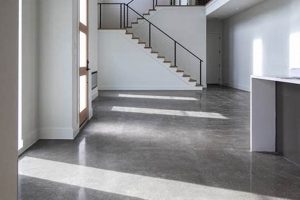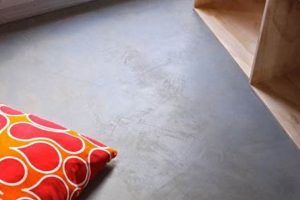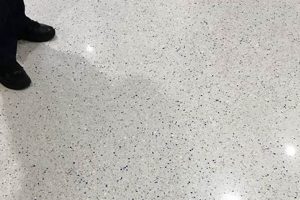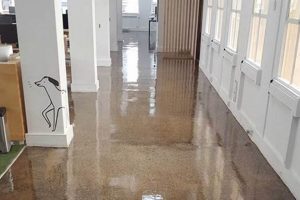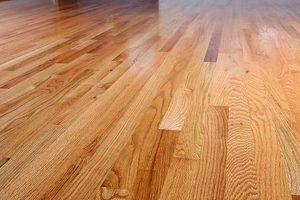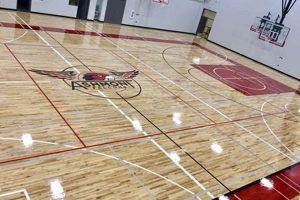A protective coating applied to gymnasium flooring surfaces safeguards the underlying material from wear, abrasion, and damage. This coating is typically composed of synthetic resins and polymers designed to create a durable, resilient barrier. An example of its application is the multi-layered treatment applied to a basketball court to protect the wood from constant foot traffic and impacts from equipment.
The application of such a coating is critical for extending the lifespan of the underlying floor and reducing maintenance costs. It provides slip resistance, enhancing safety for athletes and other users. Historically, these coatings were primarily oil-based, but contemporary formulations increasingly utilize water-based technologies for improved environmental compatibility and reduced volatile organic compound emissions.
The subsequent sections of this document will delve into the specific types of coatings available, detailing their application processes, performance characteristics, and appropriate maintenance procedures. This exploration will provide a comprehensive understanding of selecting and maintaining the appropriate surface treatment for diverse athletic flooring needs.
Essential Guidance for Optimal Gymnasium Floor Protection
The following points offer critical guidance regarding the selection, application, and maintenance of surface treatments designed for athletic flooring.
Tip 1: Material Compatibility: Prior to application, ensure the chosen coating is chemically compatible with the underlying flooring material. Incompatibility can lead to adhesion failures, discoloration, or accelerated degradation of the floor.
Tip 2: Surface Preparation: Thoroughly clean and prepare the surface before applying any coating. Remove all existing dirt, debris, wax, and previous treatments. Proper preparation is essential for achieving optimal adhesion and a uniform finish.
Tip 3: Application Technique: Adhere strictly to the manufacturer’s recommended application procedures. Factors such as coat thickness, drying time, and environmental conditions can significantly impact the performance and longevity of the coating.
Tip 4: Slip Resistance Standards: Verify that the selected coating meets established slip resistance standards, such as those outlined by ASTM or other relevant organizations. This is crucial for minimizing the risk of slips and falls.
Tip 5: Routine Maintenance: Implement a regular cleaning and maintenance schedule to remove dirt, dust, and other contaminants. Use approved cleaning agents that are specifically formulated for use on the applied surface treatment.
Tip 6: Recoating Intervals: Establish a schedule for recoating the surface based on the level of traffic and wear. Regular recoating helps to maintain the protective barrier and prolong the lifespan of the underlying flooring.
Tip 7: Environmental Considerations: When selecting a surface treatment, consider the environmental impact of the product. Opt for water-based or low-VOC formulations whenever possible to minimize emissions and promote a healthier indoor environment.
By adhering to these guidelines, facilities can maximize the performance, safety, and longevity of their athletic flooring. Consistent application of these principles contributes to a safer and more durable environment for athletic activities.
The next section will address specific product types and performance metrics in greater detail.
1. Durability
Durability, in the context of gymnasium flooring treatments, refers to the coating’s ability to withstand the wear and tear associated with intense physical activity, heavy equipment, and routine cleaning. It is a critical performance characteristic, directly impacting the lifespan of the flooring system and the frequency of maintenance interventions.
- Abrasion Resistance
Abrasion resistance is the capacity of the coating to resist damage from friction and rubbing, such as that caused by running, sliding, or the movement of equipment across the surface. A finish with high abrasion resistance will maintain its integrity and appearance longer, reducing the need for frequent recoating. For instance, a polyurethane-based coating generally offers superior abrasion resistance compared to a wax-based treatment.
- Impact Resistance
Impact resistance describes the coating’s ability to withstand sudden forces and impacts without cracking, chipping, or delaminating. In a gymnasium, this is essential to protect the floor from dropped weights, balls, or other equipment. Coatings with higher impact resistance, such as epoxy-based formulations, are often selected for areas subject to significant impact loads.
- Chemical Resistance
Chemical resistance is the ability of the surface treatment to withstand exposure to cleaning agents, spills, and other substances without degradation. Gym floors are frequently cleaned with disinfectants and detergents; therefore, the coating must resist these chemicals to prevent discoloration, softening, or erosion. For example, coatings formulated with specific crosslinking agents demonstrate improved resistance to a wider range of chemicals.
- Adhesion Strength
Adhesion strength refers to the bond between the treatment and the underlying flooring material. A strong adhesive bond is crucial for preventing the treatment from peeling, flaking, or blistering over time. Factors such as surface preparation, material compatibility, and application technique significantly influence adhesion strength. Proper sanding and cleaning of the floor before treatment application is paramount for achieving optimal adhesion.
These facets of durability are interconnected and essential for selecting an appropriate treatment for a gymnasium floor. A surface treatment exhibiting high abrasion, impact, and chemical resistance, combined with strong adhesion, will provide superior protection, extend the floor’s lifespan, and minimize maintenance requirements. Careful consideration of these factors is paramount for ensuring a safe and cost-effective athletic environment.
2. Slip Resistance
Slip resistance is a critical performance characteristic of gymnasium floor treatments, directly impacting athlete safety and liability concerns. The coefficient of friction (COF), a measure of the force required to initiate or sustain movement between two surfaces, is the primary indicator of slip resistance. A surface treatment with an inadequate COF increases the likelihood of slips and falls, potentially leading to injuries ranging from minor sprains to severe fractures. Consequently, selecting a treatment that provides a sufficient level of slip resistance is paramount. For example, a basketball court treatment designed for optimal traction allows players to make quick turns and stops without losing their footing, minimizing the risk of ankle injuries. Conversely, a treatment that is too slippery creates a hazardous environment where athletes are unable to maintain balance and control.
The level of slip resistance required for a gymnasium surface varies depending on the intended use of the facility. Multi-purpose gymnasiums used for basketball, volleyball, and other sports necessitate a treatment that provides adequate traction for a range of activities. Furthermore, the presence of dust, moisture, or other contaminants on the floor can significantly reduce slip resistance. Regular cleaning and maintenance are therefore essential for preserving the intended safety characteristics of the treatment. Specialized cleaning agents designed for athletic surfaces help to remove contaminants without compromising the integrity of the surface treatment. For instance, treatments with textured additives embedded within the coating can enhance slip resistance, particularly when the floor is slightly damp.
In summary, slip resistance is an indispensable component of any effective gymnasium floor treatment. Ensuring an adequate COF through careful selection of materials and consistent maintenance is crucial for safeguarding athletes, mitigating liability risks, and fostering a safe and productive environment. The pursuit of optimal slip resistance necessitates a comprehensive approach, integrating appropriate product selection, rigorous application procedures, and diligent maintenance practices.
3. Application Method
The application method directly influences the performance and longevity of any gymnasium flooring treatment. Improper techniques can negate the benefits of even the highest quality materials, resulting in premature failure and increased maintenance costs. The specific procedures, including surface preparation, product mixing, and the technique employed during application, are crucial determinants of the coating’s adhesion, uniformity, and overall durability. For example, applying a urethane-based treatment over an inadequately prepared surface, contaminated with dust or residual cleaning agents, will compromise adhesion, leading to peeling and blistering under heavy use. The chosen application method must align with the manufacturer’s specifications to achieve the intended performance characteristics of the treatment.
Consider the application of a water-based acrylic coating, commonly used in gymnasiums due to its low VOC content. This type of treatment typically requires multiple thin coats, each allowed to dry thoroughly before the subsequent application. The use of a high-quality microfiber applicator or a specialized coating machine ensures uniform distribution and minimizes the risk of streaking or pooling. In contrast, attempting to apply a single thick coat not only prolongs drying time but also increases the likelihood of trapped solvents, which can lead to bubbling and a weakened surface. Furthermore, the ambient temperature and humidity during application significantly affect drying time and film formation. Exceeding recommended temperature ranges may result in incomplete curing, compromising the durability and slip resistance of the surface.
In conclusion, the application method is not merely a procedural step but an integral component of a successful gymnasium flooring treatment. Strict adherence to manufacturer guidelines, the utilization of appropriate equipment, and careful monitoring of environmental conditions are essential for maximizing the lifespan and performance of the coating. Neglecting these factors can lead to compromised durability, increased maintenance, and potentially hazardous conditions for athletes. A comprehensive understanding of the application method’s impact is crucial for ensuring a safe, aesthetically pleasing, and durable athletic surface.
4. Maintenance Schedule
The longevity and performance of any gymnasium flooring treatment are inextricably linked to the implementation of a rigorous maintenance schedule. The treatment, regardless of its inherent qualities, is continuously subjected to abrasive forces, spills, and the accumulation of dust and debris. A proactive maintenance schedule mitigates the adverse effects of these factors, preserving the integrity of the coating and ensuring a safe and aesthetically pleasing athletic surface. For example, neglecting to regularly remove embedded dirt from a polyurethane treatment results in increased wear and tear, necessitating more frequent recoating and potentially compromising the floor’s slip resistance. The absence of a structured approach to cleaning and upkeep directly diminishes the protective capabilities of the treatment, accelerating its degradation and increasing the risk of athlete injury.
A well-defined maintenance schedule encompasses several key components, including routine cleaning, periodic scrubbing, and timely recoating. Daily sweeping or vacuuming removes loose dirt and debris, preventing abrasion and minimizing the potential for slips and falls. Regular scrubbing with appropriate cleaning agents, specifically formulated for the treatment in use, eliminates embedded contaminants and restores the surface’s slip resistance properties. The frequency of recoating is determined by the level of traffic and the intensity of use, typically ranging from annual to bi-annual applications. Delaying recoating allows the protective layer to wear thin, exposing the underlying flooring material to damage and significantly reducing the lifespan of the overall flooring system. Consider a high-traffic gymnasium hosting daily basketball practices and weekend tournaments; a more frequent maintenance schedule, including daily cleaning and annual recoating, is essential to maintain the floor’s safety and performance characteristics.
In conclusion, the maintenance schedule constitutes an indispensable component of the gymnasium flooring treatment. Its consistent implementation safeguards the coating from premature degradation, preserves its slip resistance properties, and extends the lifespan of the underlying flooring material. The absence of a proactive maintenance schedule undermines the investment in the initial treatment, leading to increased costs and compromised safety. By prioritizing regular cleaning, timely scrubbing, and strategic recoating, facilities can ensure a durable, safe, and aesthetically pleasing athletic surface for years to come. The symbiotic relationship between the treatment and the maintenance schedule is paramount for optimal performance and long-term cost-effectiveness.
5. Material Compatibility
The selection of a gymnasium floor treatment necessitates a meticulous evaluation of material compatibility to ensure optimal performance and longevity. The interaction between the treatment and the underlying flooring substrate dictates the success of the application. Incompatibility can manifest as adhesion failures, chemical reactions, or accelerated degradation of either the treatment or the floor. A critical understanding of these potential interactions is thus paramount to preventing costly and disruptive issues. For example, applying a solvent-based polyurethane treatment to a rubber floor can cause the rubber to swell and degrade, resulting in a compromised and potentially hazardous surface. The choice of treatment must therefore be predicated on a thorough assessment of the floor material’s chemical and physical properties.
Real-world scenarios highlight the practical significance of material compatibility. Consider a maple wood gymnasium floor, a common choice due to its durability and aesthetic appeal. A water-based acrylic treatment, known for its low VOC emissions, is often selected for such surfaces. However, if the wood has been previously treated with an oil-based product, the acrylic treatment may exhibit poor adhesion, leading to peeling and delamination. Prior to application, the existing surface must be thoroughly prepared to remove any incompatible coatings or contaminants. Similarly, the use of certain cleaning agents can also compromise the integrity of the treatment if the chemicals are not compatible with the chosen surface treatment. Compatibility charts and manufacturer specifications serve as invaluable resources in navigating these complexities.
In conclusion, material compatibility is not merely a tangential consideration but a fundamental prerequisite for a successful gymnasium floor treatment application. Addressing the potential for adverse interactions between the treatment and the flooring substrate is crucial for maximizing performance, minimizing maintenance, and ensuring the safety of athletes. Challenges persist in identifying and mitigating unforeseen compatibility issues, necessitating ongoing research and development in the field of flooring treatments. A comprehensive understanding of these principles contributes to the broader goal of creating durable, safe, and sustainable athletic environments.
6. VOC Emissions
Volatile Organic Compound (VOC) emissions from gymnasium flooring treatments constitute a significant concern regarding indoor air quality and potential health implications. These compounds, released during and after application, can contribute to respiratory irritation, headaches, and other adverse health effects, particularly in enclosed environments with limited ventilation. The composition of surface treatments directly influences the type and quantity of VOCs emitted, thereby impacting the overall environmental impact of the flooring system. For example, traditional solvent-based treatments often exhibit high VOC levels, including chemicals such as xylene and toluene, which are known to have detrimental effects on human health. The selection of surface treatment, therefore, necessitates a careful consideration of its VOC content and emission characteristics.
The adoption of low-VOC and zero-VOC surface treatments represents a significant advancement in addressing indoor air quality concerns associated with gymnasium floors. Water-based acrylic and polyurethane treatments, for instance, generally exhibit lower VOC emissions compared to their solvent-based counterparts, contributing to a healthier indoor environment for athletes and facility occupants. Regulatory agencies, such as the Environmental Protection Agency (EPA), have established guidelines and standards for VOC emissions from various products, including flooring treatments. Compliance with these regulations is essential for ensuring the environmental responsibility of facilities and mitigating potential health risks. Furthermore, third-party certification programs, such as GREENGUARD, provide independent verification of a product’s VOC emissions performance, enabling informed decision-making in the selection of surface treatments.
In conclusion, VOC emissions represent a critical factor in the selection and application of gymnasium flooring treatments. A comprehensive understanding of the types of VOCs emitted, their potential health effects, and the regulatory landscape is essential for creating a safe and sustainable athletic environment. The increasing availability of low-VOC and zero-VOC surface treatments provides facilities with viable alternatives that minimize environmental impact while maintaining the required performance characteristics. Continued research and development in this area are essential for further reducing VOC emissions and improving the overall sustainability of gymnasium flooring systems.
Frequently Asked Questions About Gymnasium Floor Treatments
The following section addresses common inquiries regarding the selection, application, and maintenance of gymnasium floor treatments. These answers are intended to provide clarity and guidance for informed decision-making.
Question 1: What is the primary purpose of a gymnasium floor treatment?
The primary purpose is to protect the underlying flooring material from wear, abrasion, and damage caused by athletic activities, heavy equipment, and routine cleaning. It also enhances safety by providing slip resistance.
Question 2: How often should a gymnasium floor be recoated?
Recoating frequency depends on the level of traffic and intensity of use. High-traffic facilities may require annual recoating, while lower-traffic facilities may only need recoating every two years.
Question 3: What factors should be considered when selecting a gymnasium floor treatment?
Critical factors include durability, slip resistance, application method, maintenance requirements, material compatibility, and volatile organic compound (VOC) emissions.
Question 4: What are the potential consequences of using an incompatible treatment?
Incompatible treatments can lead to adhesion failures, chemical reactions, accelerated degradation of the treatment or the underlying floor, and potentially hazardous conditions.
Question 5: How can slip resistance be maintained on a gymnasium floor?
Slip resistance is maintained through regular cleaning, periodic scrubbing with appropriate cleaning agents, and timely recoating when the surface shows signs of wear.
Question 6: What are the environmental considerations associated with gymnasium floor treatments?
Environmental considerations primarily relate to volatile organic compound (VOC) emissions. Selecting low-VOC or zero-VOC treatments minimizes environmental impact and promotes a healthier indoor environment.
In summary, the selection and maintenance of a gymnasium floor treatment are critical for ensuring safety, durability, and longevity. Careful consideration of all relevant factors is essential for achieving optimal results.
The next section will present a glossary of key terms related to gymnasium floor treatments.
Gym Floor Finish
This exploration has elucidated the multifaceted nature of treatments applied to gymnasium flooring. Durability, slip resistance, application method, maintenance schedule, material compatibility, and VOC emissions have been identified as critical parameters. A comprehensive understanding of these aspects is essential for selecting and maintaining appropriate protection, ultimately influencing the safety and performance of athletic environments.
The responsibility for ensuring the integrity of gymnasium floors rests with facility managers and stakeholders. Continued diligence in selecting and maintaining appropriate coatings will contribute to safer athletic environments and the preservation of valuable infrastructure. Prudent implementation of the principles outlined herein will yield long-term benefits, minimizing risk and maximizing the utility of these essential spaces.


